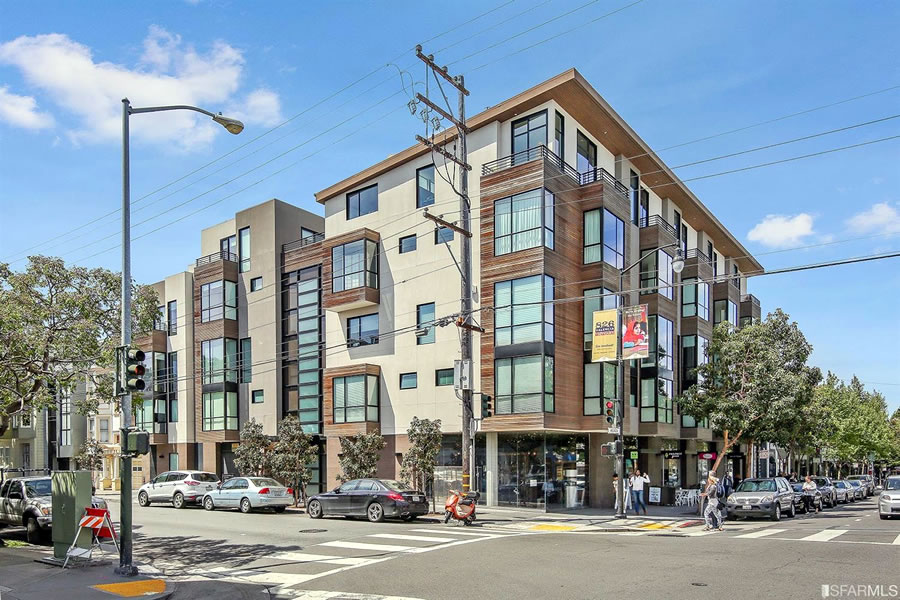Priced at $1.879 million in early 2014, the two-bedroom unit #206 at 3500 19th Street, at the corner of Valencia, sold for an even $1.800 million, or roughly $1,157 per square foot, that March.
Having returned to the market this past June priced at $1.849 million, a sale at which would have represented total appreciation of 2.7 percent over the past three years, the sale of the 1,556-square-foot unit “with an expansive open floor plan facing 19th [Street],” high-end finishes and a private deck overlooking the building’s courtyard has just closed escrow with a $1.680 million contract price.
While $1,080 per square foot certainly isn’t cheap, it is 6.7 percent ($120K) cheaper than early 2014 on an apples-to-apples basis for the Mission District condo. And yes, that’s despite the fact that the Bay Area index for condo values is at an all-time high.












Very good apple here and good market check. Looks like the kitchen was reconfigured and some built-ins added so ROI here not looking very good. The strategy of buying, improving and selling within a sub-5 year timeline is generally not a great strategy for anyone unless you happen to catch a rising market.
Although its not great for the market as a whole I personally like to see these below asking sales (twice on this property) as it tends to show a more accurate picture of what buyers are willing to pay unlike overbids where you have no sense of what the n-1 buyer was offering.
But what did the n-1 buyer offer this time around?
Comparing the n-1 price from 2014 to the ‘n’ price from now is a bananas to apple comparison. Comparing the n-1 price from 2014 to the n-1 price from now is at least bananas to bananas, but its hard to see how it’s more accurate since it is comparing two prices that no buyers actually paid ever.
There wasn’t one in either case on this property. Underbids are generally single offer situations or situations where buyers don’t feel pressured by competition and the threat of “losing the home.” People make irrational decisions in competitive situations and after “losing” a few times buyers tend to want to “win” at any cost.
I’m not good on the math part of these things, but what was the cost to the seller for the three years they spent there (taxes, staging, broker fees)?
about $450HOA + $1875 property tax + $6800 per month mortgage/insurance less $1300 deduction means their net payments were $7825 per month. Now take $100K in realtor/staging + $12,600 in transfer tax and add another $30K for a kitchen redo and divide the $142,600 by 41 months, or another $3475 per month, for a total of $11,300 per month. They probably could have rented it for $7,500 during that period, less now.
Owner was a senior manager at Uber. I take it he’s not the only one who will move out of SF, and thus, you can see why prices are dropping.
His $7800+ cost and $7500- rent explains why he couldn’t just keep it and rent it out: anyone who bought after 2013 will not be able to do that, and falling rents explains why people are going to be forced to sell, unlike years past, when he might have hung onto it to avoid the loss.
Tipster, you’re using the term “net” a little loosely. With your numbers, about $2300/month in payments goes to principal – i.e. just paying yourself. So “net payments” were more like $5500/month.
Still a terrible deal here, but mostly because of the extremely high real estate transaction costs.
“Still a terrible deal here, but mostly because of the extremely high real estate transaction costs.”
Worth considering those extremely high transaction costs when people float the canard of ‘but nobody knows exactly when a downturn will occur’.
If short term you get hit with high transaction costs and medium term you get hit with market declines, it starts looking pretty unappealing to get in at the top of a market cycle.
If you have a game where you flip a coin and heads you lose a dollar and tails you lose two dollars, there’s no need to be able to predict the outcome of the coin flip in order to see that the game is a raw deal.
At the beginning of a loan, almost all of it is interest. Furthermore, you’re double counting: he didn’t get that principal back when he sold. You just add up all the costs and money flows to get the net.
However, that brings up an interesting omission, I forgot his loss on the sale. $120K/41 or another roughly $3K per month. His cost was over $14,000 per month for something he could have rented for $7500. The $6500 difference over 41 months was well over a quarter of a million dollars he now won’t have for retirement and didn’t have to buy his next place. That tends to hold prices down.
This is exactly why the mission is going to get killed. Trendy hipster buys a bland condo that replaced a house with character or bar and then 3 years later when too many houses with character and bars have been replaced by bland condos, the hipsters all want to move to Oakland. The developers, having removed all of the character from the mission, will now move to Oakland.
Of course he got the principal payments back when he sold – you only need to pay off the loan balance, which is reduced by the sum of the principal payments, and while you’re right that most of a loan payment is interest early on, in this case, with a 30-yr loan, about $2300/month went to principal.
Agreed that if you sell after a pretty short hold and, further, sell at a loss, that is a nasty financial result.
The developers are to blame, but more so the city PTB that sold out to them rather than leverage the boom of recent years to the advantage of SF residents. The TTC fiasco is a perfect example of this as is the proposed Central SOMA plan and the TI development. The latter is a crying shame – what could have been done with TI and what actually will be done with it.
Pretty much spot on.
Sorry, but the Mission is not going to “get killed.” First, this building and nearly every other new condo building in the neighborhood has replaced a parking lot, gas station, or abandoned/unused building rather than “a house with character or bar.” Second, the neighborhood is very central with major transit and freeway connections to Downtown/Silicon Valley/SFO. Third, there are neighborhood amenities that are not going to “move to Oakland” (Dolores Park, relatively comfortable micro-climate, two BART stations, and not too far off… Bernal Hill).
The Mission may take a hit as the the City/Region goees into a downturn, but I seriously doubt that the Mission will cease to attract young-(ish) adults with healthy incomes over the long term.
“PANDA WATCH”
Here we go again! While this condo has fallen in value, there are more condos that gained in value over the same period of time. How do I know this? Socketsite regularly posts charts of median price developments and they have been showing up over the past 2-3 years (yes, for SF condo’s too!).
Looking at the comments above, this example is perceived as an indication of falling prices, which goes clearly against the reported market trend. I really don’t know why his site cherry-pics examples of negative price developments but it doesn’t convey much intellectual honesty.
SS has been accused of cherry picking since its inception. The comments are open and you are free to post whatever apples you want.
I don’t spend a ton of time looking at the market anymore and appreciate seeing early trends, or potential trends, and make my own decisions. One could make a lot of assumptions about this specific unit, maybe the Mission is over, maybe the influx of new condos and inventory are impacting the supply/demand curve, maybe both lone bidders/buyers overpaid, maybe some external factor unknown impacted this specific condo, or whatever. Or maybe the market on this place is softer than it was in 2014.
Regardless, good to see these cases, and even better to see the reaction in the comments. Haven’t seen one like the above since 2008…
“The comments are open and you are free to post whatever apples you want.”
Not really – comments are often deleted when they go against SS beliefs.
That’s factually incorrect. But comments are removed if they’re flagged for violating our general code of conduct for commenting.
I understand your code of conduct, and your enforcement is very inconsistent – perhaps you see it as trolling when people present an opinion with which you disagree. And now back to the condo on Mission Street.
[Editor’s Note: We’ve never removed a comment for presenting an opinion with which we simply disagree.]
I’ve had several comments removed, none of which oppose the editor’s position and all of which were off topic. At least in my case I’d say that the comment removal policy is fair.
Yeah, I’ve had comments removed, too. Just randomly for gently disagreeing. Sort of eviscerates trust in the site.
[Editor’s Note: We did remove two of OtherDan’s comments on this thread, neither of which were related to the specific topic(s) at hand other than extending a generic “what qualifies as news” debate.]
And here we go again for real.
While movements in the median sale price are a great measure of what’s selling, they’re not a great measure of actual appreciation or changes in value. But speaking of new developments and values, there is another index which has been trying to quantify said change.
And of course, we didn’t know the outcome of this sale prior to having picked it, but don’t let that get in the way of an ill-informed “cherry picking” barb.
To answer what ‘anon’ asked in the other thread: “(and if they [medians] are completely irrelevant, why include a monthly post reporting on median selling prices?).”
Median’s are not at all representing appreciation/depreciation or ‘gains in value’ of properties sold in the past, but rather a measure of whats selling now.
Say people move from buying generic ground beef to buying organic free-range steak. The median selling price of meat increases, but that does not indicate that the old package of ground beef you have in the fridge has increased in value.
So why even look at median sales price at all? Because to a grocery store median & sales volume is really what matters. People buying more expensive meat means more revenue and it’s really none of their concern what happens to the meat post-sale.
Similarly, much of the real estate industry is transactional. RE agents, builders, mortgage brokers all essentially derive their revenue from current transactions and generally have little to no financial ties to properties post sale. Median sales price & volume is a business metric for the business of real estate. The commission on a $2M home that used to be a $2.5M home is the same as on a $2M home that used to be a $1.5M home.
Repeat sales indices such as Case-Shiller are composed of apples-to-apples sales or use other methods to estimate changes in value of existing homes. It is primarily an investment metric.
Figure 8% transaction costs on this place. Property tax and interest on loans after deductions, and in comparison to rent on this place (7-8k/mo?) in the mission would need to be factored but it doesn’t matter. They took a risk and lost. I’m sure their bitcoin is way up. 🙂
I looked at this unit, there is no parking in this building. That was the deal-breaker for me.
I remember when these went on sale. I think another 2 bdrm unit sold for $2M. Even at the time (which we now know as height of market), there was nothing selling above $1k/sq ft. so on an apples compare, let’s just say this one got started on the outlier in the bell curve. $1.8 vs $1.7m + HOA dues… no parking… either one is brutal.
[Editor’s Note: Or as we first reported at the time, New Mission District Condos Priced At Over A Thousand A Foot.]
Here is another place that sold in March 2014, 5044 Diamond Heights Blvd #12. Sold for $973,000. Just sold again today for $1,135,000 (over asking!)
Perfectly fine to cherry-pick, of course, on one’s blog. But let’s not pretend that is a fair or representative way to measure anything – no different from realtor sites that feature only upside results. If you think for 2 seconds this 19th St. result is not an outlier, and you think you’re going to be able to buy a place in SF for less than 2014 prices, you will be sorely disappointed. Maybe after 31% of the population leaves within 3 years, but not today . . .
Meanwhile back in the Mission, versus the tighter market for four-bedrooms up in Diamond Heights, there is a growing list of “outliers” with sub-2015 pricing that have yet to be picked.
That being said, we’d agree that pre-2014 pricing isn’t the norm. But whatever happened to “anyone looking for big discounts off the 2014 or 2015 or 2016 price is going to be sorely disappointed?” Of course, that was a month ago…
By the way, the original asking price for that Diamond Heights pad was $1.195 million. And while it was subsequently changed to $1.135 million, the actual sale price was $1.100 million and $615 per square foot.
Ah, yes, only sold for $127,000 over the 2014 price, not $162,000. Hardly a market crash. And no change, anyone looking for big discounts off the 2014 or 2015 or 2016 price is going to be sorely disappointed. The case shiller numbers just confirmed that. Who knows what will happen in the future? Could fall 20%, could rise 20%. I’m just saying that today you have to hunt broadly, cherry-pick, and ignore the majority of “apples” and all the broad data to come up with a story that prices have already come down, and that story will have more holes than a can of SpaghettiO’s.
That’s right, total appreciation of 13.1 percent since early 2014 for your Diamond Heights example. Which is weird, because according to the Bay Area index upon which you keep hanging your hat upon, the condo market was up over 23 percent from 2014 through the end of 2015 alone.
Nope, there’s nothing to see nor understand here and certainly no evidence of a market shift (nor a growing list of discounted properties to be had). But it’s good to keep using the word ‘crash’ to maintain your straw man.
And now back to the Mission and the actual market at hand…
OK, got it. Back to that line. A $127,000 gain in 3 years is really a price drop. If one must accept such “logic,” then I agree prices have dropped! But that’s only if one accepts such silly logic. In the real world, a different story.
Brilliant! And don’t forget there was never any downturn in 2008 or 2009. Because compared to prices 20 years before, which were lower, the market was actually up!
Which once again brings us back to the real world and a growing list of so-called “outliers.” Speaking of which, the list price for the two-bedroom #502 at 72 Townsend was dropped to $1,495,000 today which is a real 10.3 percent discount to the price at which it sold in the fourth quarter of 2015.
“A $127,000 gain in 3 years is really a price drop. If one must accept such “logic,” then I agree prices have dropped!”
Not a price drop over the whole three year period, but it could represent two years of large price gains followed by one year of steep price drops. In fact the irony of your snark, is that this is exactly the methodology of the Case-Shiller index, which as the ed points out you keep hanging your hat on.
If you have a 2014 to 2015 apple to apple showing a 23% gain and a similar 2014 to 2016 apple to apple showing a 13% gain, then you can infer a 10% loss from 2015 to 2016.
And this is exactly how Case-Shiller and other repeat sales indices are constructed. They take a matrix of repeat sales, all with varying time periods between sales, and compute from them a price index at every point in time that is most consistent (least error) to all the sales pairs.
As I’ve said, when you’re reduced to arguing that price gains are really declines — because, you know, indexes whose validity I dispute because they pretty conclusively show prices are still rising a bit, kind of, sort of, maybe so indicate — you’re just in la-la logic land.
I accept this place and a handful of others SS has dug up have sold for less. The issue is the conclusion to be drawn from that. Given that the broader indexes show continued rising, and far more “Apples” also show appreciation, the reasonable conclusion is they are outliers. This is the opposite of 2009 when the indexes we’re all down but realtors argued they were wrong because, you know, here is an anecdote where a place went up.
Potrero Hill Condo Succeeds in Fetching Over 2014 Price
415 De Haro Street #306 closed escrow on Aug 25, 2017 for $1.6 mil, originally purchased for $1.425 mil in May 2014.
Just to add another example to the unrepresentative sample here.
Once again, a condo selling for over its 2014 price shouldn’t catch anybody by surprise, which is precisely why the outcome for 3500 19th Street #206 – which we don’t know prior to having picked it – should raise an eyebrow (or two).
At the same time, a Potrero Hill apple demonstrating total appreciation of 12.3 percent since early 2014 isn’t exactly a sign of current market strength considering how the market was moving through the end of 2015.
Fine, here’s another one. 1940 Sacrament #6. $1,450,000 in August 2016. Just sold again for $1,850,000. Yeah, some work on floors and enlarging a bathroom, and a new boiler. Call it a conservative 20% rise (heck call it 10% or 5% if you want to speculate on costs of pretty minor work). At any rate, Pretty significant rise in the last 12 months.
This is why the broader indexes are a far better measure of “the market.” Anecdotes only get you so far and, by definition, tell only a very small part of the story, particularly if no effort is made to choose a representative sample.
Wow, it’s hard to believe that a Pacific Heights condo that was “renovated throughout [its] 1700 square foot interior” would sell for more than prior to said renovations and the cost of the work (which included a new master bath, the removal of walls and an opening of the floor plan).
But we agree, indexes are great when property employed. That being said, it’s amazing how many people don’t understand the indexes they’re quoting and abandon those which are more specific to a particular segment of the market once they don’t match one’s beliefs or spin.
The irony here is that even the link you provide shows a price rise from 2014 to 2016 and a price decline thereafter in the Redfin price estimate.
To be clear, while they are probably using a repeat sales methodology and may well have smart people working on it, I wouldn’t use a proprietary price estimate such as the Redfin estimate as a ‘Tier 1’ data source. But it just points out that it’s far from controversial that prices could have gone up for a few years and then gone down.
Everyone’s entitled to their own opinion, but for those still preaching the ‘endless summer’/’there’s nothing to see here the market’s still booming’ line, it might be worth looking at how even the tone of Realtors has shifted.
I count 26 uses of the word ‘bubble’ in this post by a real estate firm. And the question of a downturn is not one of ‘if’ but of ‘when’ and ‘how much’.
Contrast that to the days of people wondering how we could even have a bubble and if there even was such a thing as a ‘bubble’ and postulating that the boom was sustainable.
You can focus on the tactical rhetorical battle over specific apples, but ignoring that fact that the debate once was around if the boom was sustainable and now it’s around the extent of sub 2014/2015 sales is missing the forest for the trees.
Plateau. SF real estate is generally in a plateau. Some sold for over asking, some sold for under.
Sadly, a plateau doesn’t make for good headlines.
I wish instead of one 1600 square foot two-bedroom, this had been built as two 800 square foot two-bedrooms. Still plenty of space for a small family, and would have let more people enjoy this ideal location.
UPDATE: A Re-Resale Round Trip for a Contemporary Mission District Condo